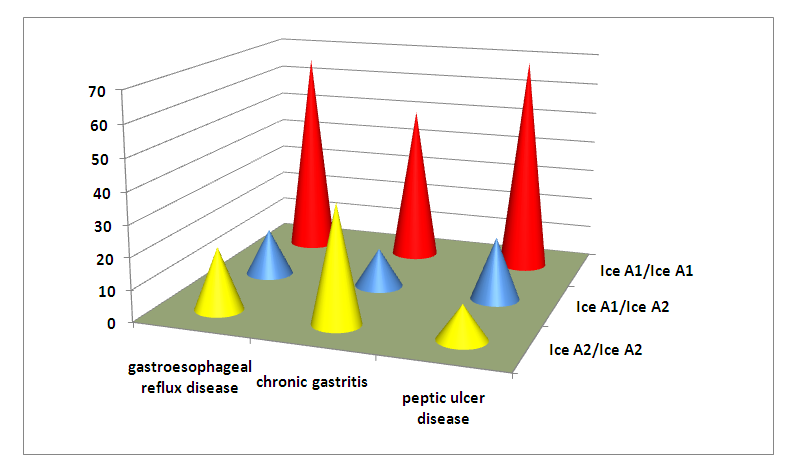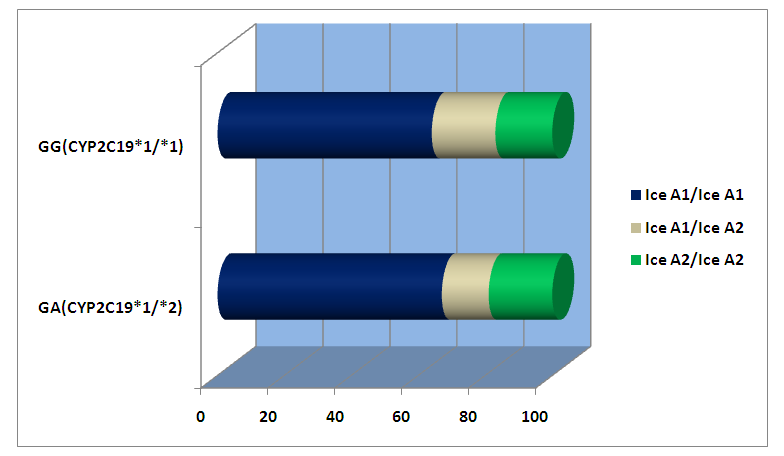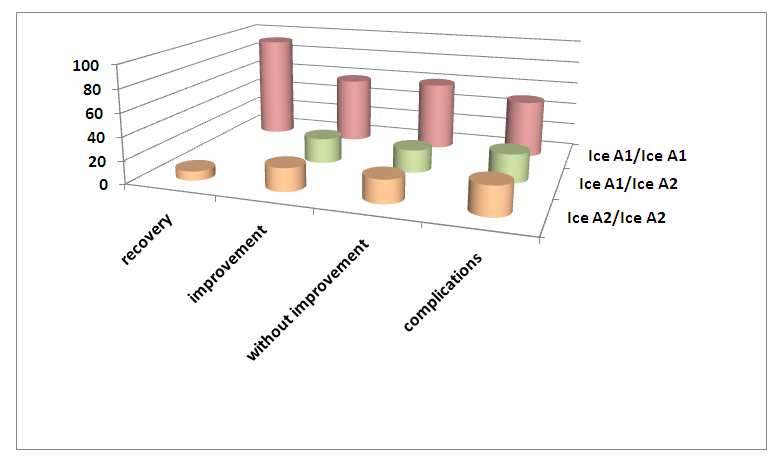-
Paper Information
- Previous Paper
- Paper Submission
-
Journal Information
- About This Journal
- Editorial Board
- Current Issue
- Archive
- Author Guidelines
- Contact Us
American Journal of Medicine and Medical Sciences
p-ISSN: 2165-901X e-ISSN: 2165-9036
2022; 12(12): 1325-1329
doi:10.5923/j.ajmms.20221212.30
Received: Dec. 9, 2022; Accepted: Dec. 20, 2022; Published: Dec. 23, 2022

The Relationship of the Genotypes of H.Pylori Bacteria with the Genotypes of Drug Pharmacokinetics Genes in Acid-Dependent Diseases of the Digestive System
Musayeva Dilfuza Makhmudovna
Bukhara State Medical Institute named after Abu Ali Ibn Sino, Bukhara, Uzbekistan
Correspondence to: Musayeva Dilfuza Makhmudovna, Bukhara State Medical Institute named after Abu Ali Ibn Sino, Bukhara, Uzbekistan.
| Email: |  |
Copyright © 2022 The Author(s). Published by Scientific & Academic Publishing.
This work is licensed under the Creative Commons Attribution International License (CC BY).
http://creativecommons.org/licenses/by/4.0/

The article reveals the results of a study of the relationship of the genotypes of the virulent gene Ice A of H.pylori bacteria with the genotypes of the gene СУР2С19 of patients with acid-dependent diseases of the digestive system and their effect on the results of pharmacotherapy of acid-dependent diseases of the digestive system, such as gastroesophageal reflux disease, chronic gastritis and peptic ulcer of the stomach and duodenum. Recommendations for personification of pharmacotherapy of acid-dependent diseases of the digestive system are indicated, taking into account the genotypes of the patient and H.pylori bacteria.
Keywords: Virulent gene IceA 1 N.pylori, Genotypes, Acid-dependent diseases of the digestive system, Pharmacotherapy, Personification of pharmacotherapy, Gene CYP2C19, Drug pharmacokinetics genes
Cite this paper: Musayeva Dilfuza Makhmudovna, The Relationship of the Genotypes of H.Pylori Bacteria with the Genotypes of Drug Pharmacokinetics Genes in Acid-Dependent Diseases of the Digestive System, American Journal of Medicine and Medical Sciences, Vol. 12 No. 12, 2022, pp. 1325-1329. doi: 10.5923/j.ajmms.20221212.30.
1. Introduction
- Based on modern concepts, H.pylori is not only one of the most common pathogenic bacteria, but also one of the leading aggressive factors in the pathogenesis of acid–dependent diseases [1,14,17]. The genome of H. pylori contains genes associated with increased pathogenicity of the microorganism — vacA, CagA, iceA, babA [7,2,9]. Their presence is associated with the development of the most significant diseases of the stomach: from gastroesophageal reflux disease, chronic gastritis, gastric and duodenal types of peptic ulcer disease, up to stomach cancer [8,12,16]. One of the main pathogenicity factors is the cytotoxicity gene — iceA (induced by contact with epithelium), activated by contact with epithelial cells of the gastric mucosa, which has two allelic forms — iceA1 and iceA2. Scientists of the world believe that patients infected with H. pylori with the iceA1 genotype have higher infiltration of their own plate of the gastric mucosa by polymorphonuclear neutrophils than those infected with another genotype. There is evidence indicating that the iceA1 allele is more common in peptic ulcer disease, and iceA2 is associated with gastritis [2,11,15].Eradication of H. pylori infection is of great importance for the restoration of a normal lifestyle of a patient with gastrointestinal diseases. To eradicate H. pylori bacteria, gastroenterologists of the world use the recommendations of Maastricht V and the Kyoto Consensus. According to the Maastricht Agreements, after the application of eradication therapy, it is considered effective if the degree of H. pylori eradication reaches at least 80%. However, if during the initial application of eradication schemes the effectiveness reached the necessary figures, then recently there has been a decrease in the effectiveness of therapy to 65-75%. Among the many reasons for the ineffectiveness of pharmacotherapy, researchers point to the genetic characteristics of the patient, which are noted as the main reason not only for the decrease in the effect of therapy, but also for the development of side effects of drugs [3,6].It is known that almost all pharmacological agents, being substrates of cytochrome P-450, have corresponding isoforms of this system, which, being inhibitors or inducers in activity, differ from each other only in substrate specificity [4]. It should be noted that the genes encoding these enzymes occupy a special place in the process of biotransformation of drugs, therefore the genetic variability of the genes involved in this process directly affects the manifestation of individual sensitivity to pharmacological agents [5]. The CYP2C19 gene encodes a member of the cytochrome P450 enzyme superfamily, which is an important phase I enzyme widely expressed in endothelial and smooth muscle cells. The enzyme is localized in the endoplasmic reticulum and is a monooxygenase – an enzyme that catalyzes the addition of one oxygen atom. This enzyme participates in the metabolism of many drugs, the synthesis of cholesterol, steroids and other lipids. Mutations in the CYP2C19 gene can lead to a change in the activity of the enzyme encoded by it [13].It is known that polymorphisms of the CYP2C19 gene are manifested by three main phenotypic variants of metabolizers. The first is the extensive type, characterized by the normal course of metabolic processes of pharmacotherapy drugs. The second variant of the phenotypic manifestation includes slow metabolizers, which are also called "zero", since they are synthesized defective and therefore the metabolism of the drugs used is reduced. Therefore, either reduce the dose of the drug, or change it to another drug. And finally, the third variant of the phenotypic manifestation is rapid metabolizers, where the metabolism of the drugs used is increased and it is difficult to achieve the desired dose of the drug in the tissue, as a result of which it is recommended to increase the dose of the drug compared with normal metabolizers [5].Based on the above, it should be noted that the widespread prevalence of acid-dependent diseases, especially its associated form with H. pylori, the ineffectiveness of the recommended lines of eradication therapy and the poorly studied personal approach to treatment, taking into account the genetic characteristics of patients with acid-dependent diseases, served as the impetus for our study. Therefore, in our opinion, it seems relevant to determine the genetic markers of the prognosis of pharmacotherapy of acid-dependent diseases.The aim of this study was to study the relationship of the genotypes of the virulent gene Ice A of H.pylori bacteria with the genotypic features of the polymorphism G681A of the gene CYP2C19 of patients with acid-dependent diseases in the form of gastroesophageal reflux disease, chronic gastritis, peptic ulcer disease and their effect on clinical manifestations, as well as the results of pharmacotherapy of these diseases.
2. Materials and Methods
- A comprehensive examination of 120 patients with acid-dependent diseases was carried out, of which 37 patients with gastroesophageal reflux disease, 43 patients with chronic gastritis and 40 patients with peptic ulcer disease who were hospitalized in the gastroenterology department and monitored in the 1st clinic of the Bukhara Regional Multi-profile Clinical Hospital and in the treatment and diagnostic center "Mohi Hossa". These patients were included in the main study group.The control group included 42 healthy people who had no history of gastrointestinal tract disease, who corresponded by gender and age to the main study group.The age of patients with acid–dependent diseases ranged from 18 to 79 years, men were 74 (62%), women - 46 (38%), that is, men significantly prevailed in the sample of patients with acid-dependent diseases.In the course of molecular genetic studies, biological material was taken from the stomach of patients in the form of a biopsy to isolate the DNA of H. pylori bacteria. The collection of material and extraction of genomic DNA from the peripheral blood of patients was carried out taking into account the established human rights procedure, which was carried out after a medical examination with the written consent of the subjects (Universal Declaration on the Human Genome and Human Rights (November 11, 1997)). Genomic DNA was isolated from whole peripheral venous blood. Blood sampling was performed using a vacuum system containing K2- Ethylenediaminetetraacetic acid as an anticoagulant. DNA isolation was carried out in accordance with the instructions of the DNA/RNA isolation kit (Ribot-prep, Interlabservice, Russia) or with the methodology, Mathew S. S., 1984, with some modifications. Genotyping of DNA samples by the CYP2C19 gene was carried out by real-time PCR using oligonucleotide primers and allele-specific fluorescent probes using a PCR-RV kit (manufactured by Syntol LLC (Moscow, Russia)). Real-time PCR amplification was performed using a standard protocol. For real-time PCR amplification, Dt lite 4 Real-Time PCR with a 48-cell block was used. FAM and NEX detectors were introduced into the program. The obtained results were documented in the form of growth curves for two FAM and NEX detectors in graphical mode on the corresponding program. Statistical processing of the results of the study was carried out by a generally accepted method using the Student's criterion.
3. Result and Discussion
- Science knows that the virulent gene IceA of H.pylori bacteria has 3 genotypic variants: IceA1/IceA1, IceA1/IceA2 and Ice A2/Ice A2. When studying the comparative characteristics of the occurrence of genotypic variants of H.pylori bacteria in patients with acid-dependent diseases, it turned out that in patients with gastroesophageal reflux disease, the genotype Ice A1/Ice A1 occurs about 65%, while the genotypes Ice A1/Ice A2 and Ice A2/Ice A2 are detected within 15% and 20% (fig. 1).
 | Figure 1. Frequency of occurrence of virulent gene genotypes Ikea H.pylori bacteria in patients with acid-dependent diseases (%) |
 | Figure 2. Occurrence of virulent gene genotypes Ikea of H.pylori bacteria in relation to the genotypes of the G 681 A polymorphism of the CYP2C19 gene in patients with acid-dependent diseases (%) |
 | Figure 3. Relationship of genotypes of the virulent gene Ice A H.pylori bacteria with the result of pharmacotherapy of acid-dependent diseases |
4. Conclusions
- Based on the above, it should be noted that the genotype IceA1/IceA1 of the virulent gene of the bacterium Ice infection H.pylori is detected in patients with acid-dependent diseases to a greater extent than other genotypes of the bacterium. In addition, this genotype of H.pylori bacteria is more often associated with the “wild” allele variant of the G polymorphism G681A of the gene CYP2C19, responsible for the metabolism of proton pump inhibitors - drugs of the main series during the eradication of H.pylori infection. This indicates the influence of the genotypes of both the patient and the bacteria on the results of pharmacotherapy. As it was revealed, in patients with the presence of the IceA1/IceA1 genotype of the virulent gene of the H.pylori infection Ice bacterium, eradication therapy was successful and recovery was in the greatest cases. Thus, the genotyping of both the patient and H.pylori bacteria have individual characteristics, which indicates the personification of pharmacotherapy.
 Abstract
Abstract Reference
Reference Full-Text PDF
Full-Text PDF Full-text HTML
Full-text HTML